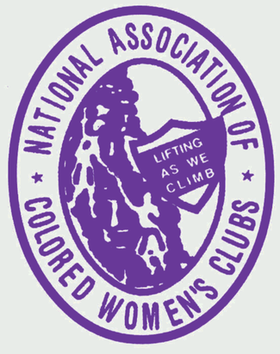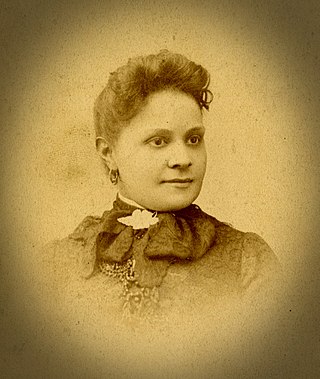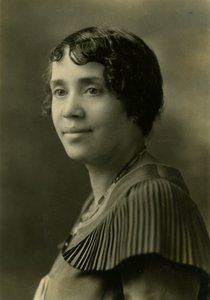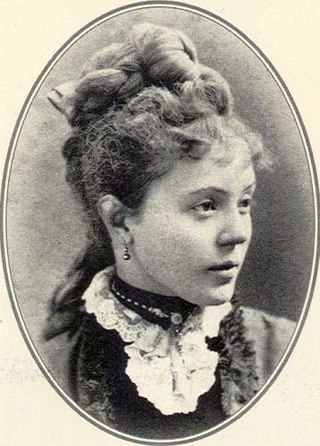Related Research Articles

The National Association of Colored Women's Clubs (NACWC) is an American organization that was formed in July 1896 at the First Annual Convention of the National Federation of Afro-American Women in Washington, D.C., United States, by a merger of the National Federation of Afro-American Women, the Woman's Era Club of Boston, and the Colored Women's League of Washington, DC, at the call of Josephine St. Pierre Ruffin. From 1896 to 1904 it was known as the National Association of Colored Women (NACW). It adopted the motto "Lifting as we climb", to demonstrate to "an ignorant and suspicious world that our aims and interests are identical with those of all good aspiring women." When incorporated in 1904, NACW became known as the National Association of Colored Women's Clubs (NACWC).
Josephine St. Pierre Ruffin was a publisher, journalist, civil rights leader, suffragist, and editor of the Woman's Era, the first national newspaper published by and for African-American women.

Mary Church Terrell was one of the first African-American women to earn a college degree, and became known as a national activist for civil rights and suffrage. She taught in the Latin Department at the M Street School —the first African American public high school in the nation—in Washington, DC. In 1895, she was the first African-American woman in the United States to be appointed to the school board of a major city, serving in the District of Columbia until 1906. Terrell was a charter member of the National Association for the Advancement of Colored People (1909) and the Colored Women's League of Washington (1892). She helped found the National Association of Colored Women (1896) and served as its first national president, and she was a founding member of the National Association of College Women (1923).

Frances "Fannie" Barrier Williams was an African American educator, civil rights, and women's rights activist, and the first black woman to gain membership to the Chicago Woman's Club. She became well known for her efforts to have black people officially represented on the Board of Control of the World's Columbian Exposition in 1893. She was also a musician, a portraitist and studied foreign languages.

Mary Burnett Talbert was an American orator, activist, suffragist and reformer. In 2005, Talbert was inducted into the National Women's Hall of Fame.

Sallie Wyatt Stewart was an American educator and a social services organizer for the black community in Evansville, Indiana, who is best known for her leadership in local, state, and national black women’s clubs. Stewart served as president of the Indiana Federation of Colored Women from 1921 to 1928 and succeeded Mary McLeod Bethune as president of the National Association of Colored Women from 1928 to 1933. During her term as the IFCW's president, Stewart launched "The Hoosier Woman", a monthly newsletter that served as the organization's official publication. Among her accomplishments as the NACW's president was the founding in 1930 of the National Association of Colored Girls. In addition, Stewart was a delegate in 1930 to the International Council of Women in Vienna, Austria, and fourth vice president of the National Council of Women of the United States. She also served a trustee and secretary of the Frederick Douglass Memorial and Historical Association, a member of the executive committee of the National Negro Business League, a member of the executive committee of the National Colored Merchants Association, and a teacher in the Evansville public schools for more than fifty years.

Daisy Elizabeth Adams Lampkin was an American suffragist, civil rights activist, organization executive, and community practitioner whose career spanned over half a century. Lampkin’s effective skills as an orator, fundraiser, organizer, and political activist guided the work being conducted by the National Association of Colored Women (NACW); National Association for the Advancement of Colored People (NAACP); National Council of Negro Women and other leading civil rights organizations of the Progressive Era.
African-American women began to agitate for political rights in the 1830s, creating the Boston Female Anti-Slavery Society, Philadelphia Female Anti-Slavery Society, and New York Female Anti-Slavery Society. These interracial groups were radical expressions of women's political ideals, and they led directly to voting rights activism before and after the Civil War. Throughout the 19th century, African-American women such as Harriet Forten Purvis, Mary Ann Shadd Cary, and Frances Ellen Watkins Harper worked on two fronts simultaneously: reminding African-American men and white women that Black women needed legal rights, especially the right to vote.

Elizabeth Beatrice Cooke Fouse was a woman from Kentucky, dedicated to gaining equality for African American women on both local and national levels. She founded as well as became the head of many organizations, with the ultimate goal of ending discrimination. Her Christian faith was critical to her activities in social and church-related clubs.

Josephine Silone Yates was an American professor, writer, public speaker, and activist. She trained in chemistry and became one of the first black professors hired at Lincoln University in Jefferson City, Missouri. Upon her promotion, she became the first black woman to head a college science department. She may have been the first black woman to hold a full professorship at any U.S. college or university.

Ella Lillian Davis Browne Mahammitt was an American journalist, civil rights activist, and women's rights activist from Omaha, Nebraska. She was editor of the black weekly The Enterprise, president of Omaha's Colored Women's Club, and an officer of local branches of the Afro-American League. On a national stage, in 1895 she was vice-president of the National Federation of Afro-American Women, headed by Margaret James Murray, and in 1896 was a committee member of the successor organization, the National Association of Colored Women, under president Mary Church Terrell.
The First National Conference of the Colored Women of America was a three-day conference in Boston organized by Josephine St. Pierre Ruffin, a civil rights leader and suffragist. In August 1895, representatives from 42 African-American women's clubs from 14 states convened at Berkeley Hall for the purpose of creating a national organization. It was the first event of its kind in the United States.

Victoria Clay Haley, later Victoria Clay Roland, was an American suffragist, clubwoman, bank executive, and fundraiser based in St. Louis, Missouri and later in Chicago.

Roberta Johnson Dunbar was an American clubwoman and peace activist based in Rhode Island. Her first name is sometimes written "Reberta" in sources.
The Woman's Era Club was an African-American women's civic organization founded in Boston, Massachusetts, in between 1892 and 1894 by Josephine St. Pierre Ruffin. The Club was the first black women's club in Boston. The organization was especially well-known for the conflict caused when Ruffin attempted to desegregate the General Federation of Women's Clubs (GFWC) in 1900.

Josephine Beall Willson Bruce was a women's rights activist in the late 1890s and early 1900s. She spent a majority of her time working for the National Organization of Afro-American Women. She was a prominent socialite in Washington, D.C. throughout most of her life where she lived with her husband, United States Senator Blanche Bruce. In addition to these accomplishments, she was the first black teacher in the public school system in Cleveland, and she eventually became a highly regarded educator at Tuskegee University in Alabama.

Mary Jackson McCrorey was an American educator, mission worker, and leader in the Young Women's Christian Association (YWCA).

Sadie L. Adams was an African-American teacher, suffragist, and clubwoman. She was one of the first women to serve on an election board in Chicago and one of the founders of the Douglas League of Women Voters. In 1916, she served as a delegate from Chicago's first black suffrage organization, the Alpha Suffrage Club, to the National Equal Rights League conference. She was elected president of the Chicago and Northern District Association of Colored Women's Clubs in 1921, serving into 1934. She was also involved in various charity clubs and organizations that helped to engage women in war work during World War I, provide resources for underserved youth, and increase suffrage for Black women.

Helen Appo Cook was a wealthy, prominent African-American community activist in Washington, D.C., and a leader in the women's club movement. Cook was a founder and president of the Colored Women's League, which consolidated with another organization in 1896 to become the National Association of Colored Women (NACW), an organization still active in the 21st century. Cook supported voting rights and was a member of the Niagara Movement, which opposed racial segregation and African American disenfranchisement. In 1898, Cook publicly rebuked Susan B. Anthony, president of the National Woman's Suffrage Association, and requested she support universal suffrage following Anthony's speech at a U.S. Congress House Committee on Judiciary hearing.

Phyllis Terrell Langston was a suffragist and civil rights activist. She worked alongside her mother, Mary Church Terrell, in the National Association of Colored Women's Clubs and the White House pickets during demonstrations made by the National Woman's Party.
References
- 1 2 3 4 5 Brooks, Robin (2018-08-18). "Looking to Foremothers for Strength: A Brief Biography of the Colored Woman's League". Women's Studies. 47 (6): 609–616. doi:10.1080/00497878.2018.1492407. ISSN 0049-7878.
- 1 2 "Colored Woman's National League. A Member of The National Council". Readex: America's Historical Newspapers. April 4, 1896.
- 1 2 3 4 5 Giles, Mark S. (2006). "Special Focus: Dr. Anna Julia Cooper, 1858-1964: Teacher, Scholar, and Timeless Womanist". The Journal of Negro Education. 75 (4): 621–634. ISSN 0022-2984. JSTOR 40034662.
- 1 2 3 "EWWRP : Women's Advocacy Collection : The Woman's Era, Volume 1 : Club News 0". womenwriters.digitalscholarship.emory.edu. Retrieved 2019-12-09.
- ↑ Kletzing, H. F; Crogman, W. H (1987). Progress of a race, or, The remarkable advancement of the Afro-American Negro from the bondage of slavery, ignorace, and poverty to the freedom of citizenship, intelligence, afflunce, honor and trust. OCLC 1013367734.
- 1 2 "Two Calls". Readex: America's Historical Newspapers. June 20, 1896.
- 1 2 3 Tepedino, Therese. "The Founding and Early Years of the National Association of Colored Women". PDXScholar.
- 1 2 Jones, Beverly W. (1982). "Mary Church Terrell and the National Association of Colored Women, 1896 to 1901". The Journal of Negro History. 67 (1): 20–33. doi:10.2307/2717758. ISSN 0022-2992. JSTOR 2717758.
- ↑ Lerner, Gerda (1974). "Early Community Work of Black Club Women". The Journal of Negro History. 59 (2): 158–167. doi:10.2307/2717327. ISSN 0022-2992. JSTOR 2717327.
- ↑ "Woman's Column". Readex: America's Historical Newspapers. May 2, 1896.